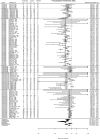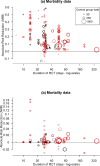Do antimicrobial mass medications work? A systematic review and meta-analysis of randomised clinical trials investigating antimicrobial prophylaxis or metaphylaxis against naturally occurring bovine respiratory disease
- PMID: 28830074
- PMCID: PMC7108556
- DOI: 10.1093/femspd/ftx083
Do antimicrobial mass medications work? A systematic review and meta-analysis of randomised clinical trials investigating antimicrobial prophylaxis or metaphylaxis against naturally occurring bovine respiratory disease
Abstract
A distinct difference between veterinary and human medicine is the routine use of antimicrobial mass medications (prophylaxis, metaphylaxis) to healthy individuals. The need for antimicrobial mass medications is based on beliefs that group/s of animals will contract a bacterial disease (i.e. morbidity) and/or die (i.e. mortality). Bovine respiratory disease (BRD) represents the major indication for cattle antimicrobials worldwide. The objectives were to perform a systematic review and meta-analysis of randomised controlled clinical trials (RCTs) for naturally occurring BRD investigating antimicrobial prophylaxis/metaphylaxis to prevent morbidity/mortality. In total, 58 publications met the inclusion criteria summarizing 169 individual RCTs, spanning 50 years (1966-2016). Antimicrobial prophylaxis and metaphylaxis demonstrated moderate, yet highly variable relative risk reductions in BRD morbidity. These were dependent on the antimicrobial classes used, dependent on metaphylaxis definition, BRD attack rates and duration of the RCTs. Best relative risk reductions were from broad-spectrum critically important antimicrobials, or combinations. BRD prophylaxis/metaphylaxis represents major antimicrobial consumption for highly variable short-term gains in absolute risk reduction of morbidity/mortality. Despite widespread use of prevention products, the need for antimicrobial mass medications should be re-evaluated since the underlying problem is more likely the segmented infrastructure of the feedlot and veal calf industries compared to the disease itself.
Keywords: antimicrobial; bovine; metaphylaxis; prophylaxis.
© FEMS 2017. All rights reserved. For permissions, please e-mail: journals.permissions@oup.com.
Figures





Similar articles
-
A mixed treatment comparison meta-analysis of metaphylaxis treatments for bovine respiratory disease in beef cattle.J Anim Sci. 2017 Feb;95(2):626-635. doi: 10.2527/jas.2016.1062. J Anim Sci. 2017. PMID: 28380607 Review.
-
Intravenous magnesium sulphate and sotalol for prevention of atrial fibrillation after coronary artery bypass surgery: a systematic review and economic evaluation.Health Technol Assess. 2008 Jun;12(28):iii-iv, ix-95. doi: 10.3310/hta12280. Health Technol Assess. 2008. PMID: 18547499
-
Systemic pharmacological treatments for chronic plaque psoriasis: a network meta-analysis.Cochrane Database Syst Rev. 2021 Apr 19;4(4):CD011535. doi: 10.1002/14651858.CD011535.pub4. Cochrane Database Syst Rev. 2021. Update in: Cochrane Database Syst Rev. 2022 May 23;5:CD011535. doi: 10.1002/14651858.CD011535.pub5. PMID: 33871055 Free PMC article. Updated.
-
Drugs for preventing postoperative nausea and vomiting in adults after general anaesthesia: a network meta-analysis.Cochrane Database Syst Rev. 2020 Oct 19;10(10):CD012859. doi: 10.1002/14651858.CD012859.pub2. Cochrane Database Syst Rev. 2020. PMID: 33075160 Free PMC article.
-
Intracavity lavage and wound irrigation for prevention of surgical site infection.Cochrane Database Syst Rev. 2017 Oct 30;10(10):CD012234. doi: 10.1002/14651858.CD012234.pub2. Cochrane Database Syst Rev. 2017. PMID: 29083473 Free PMC article.
Cited by
-
Economic effects of policy options restricting antimicrobial use for high risk cattle placed in U.S. feedlots.PLoS One. 2020 Sep 15;15(9):e0239135. doi: 10.1371/journal.pone.0239135. eCollection 2020. PLoS One. 2020. PMID: 32931522 Free PMC article.
-
Antimicrobial resistance determinants in silage.Sci Rep. 2022 Mar 28;12(1):5243. doi: 10.1038/s41598-022-09296-5. Sci Rep. 2022. PMID: 35347213 Free PMC article.
-
Antimicrobial use in animal farms in Egypt: rates, patterns, and determinants.J Egypt Public Health Assoc. 2025 Jan 20;100(1):1. doi: 10.1186/s42506-024-00180-w. J Egypt Public Health Assoc. 2025. PMID: 39828782 Free PMC article.
-
Association of Lung Consolidation Depth With Pathogens Isolated From Bronchoalveolar Lavage Fluid in Calves With Clinical Signs of Respiratory Disease.J Vet Intern Med. 2025 May-Jun;39(3):e70120. doi: 10.1111/jvim.70120. J Vet Intern Med. 2025. PMID: 40401500 Free PMC article.
-
Immunomodulatory Effects of Macrolides Considering Evidence from Human and Veterinary Medicine.Microorganisms. 2022 Dec 9;10(12):2438. doi: 10.3390/microorganisms10122438. Microorganisms. 2022. PMID: 36557690 Free PMC article. Review.
References
-
- Albak C, Bradstock L, Cruise L. Prophylactic treatment of feedlot calves at processing with a long-acting oxytetracycline. Bovine Pr 1986;21:192–4.
-
- Anonymous. Comparative efficacy of DRAXXIN™ or Micotil® for the control of respiratory disease in cattle at high risk of developing undifferentiated bovine respiratory disease. Pfizer Animal Health Technical Bulletin 2005.
-
- Anonymous. Metaphylactic use of DRAXXIN® (tulathromycin) in weaned dairy calves at high risk for infectious respiratory disease. Technical Bulletin DRX13045 2013.
-
- Bechtol DT, Johnson EG, Lechtenberg KF et al. . Multi-center field dose confirmation study of a single injection of 4 mg/kg body weight of 20, 23-di-piperdinyl-mycaminosyl-tylonolide (tildipirosin) in cattle at high risk for developing bovine respiratory disease. Study Number 2052-009-00. 2012;NADA 141–334:Freedom of Information Act Summary.
Publication types
MeSH terms
Substances
LinkOut - more resources
Full Text Sources
Other Literature Sources
Miscellaneous

